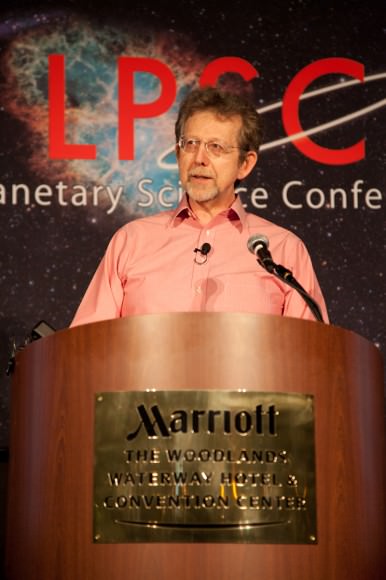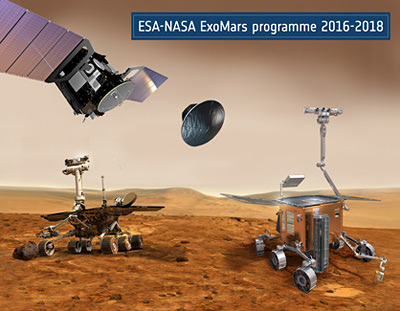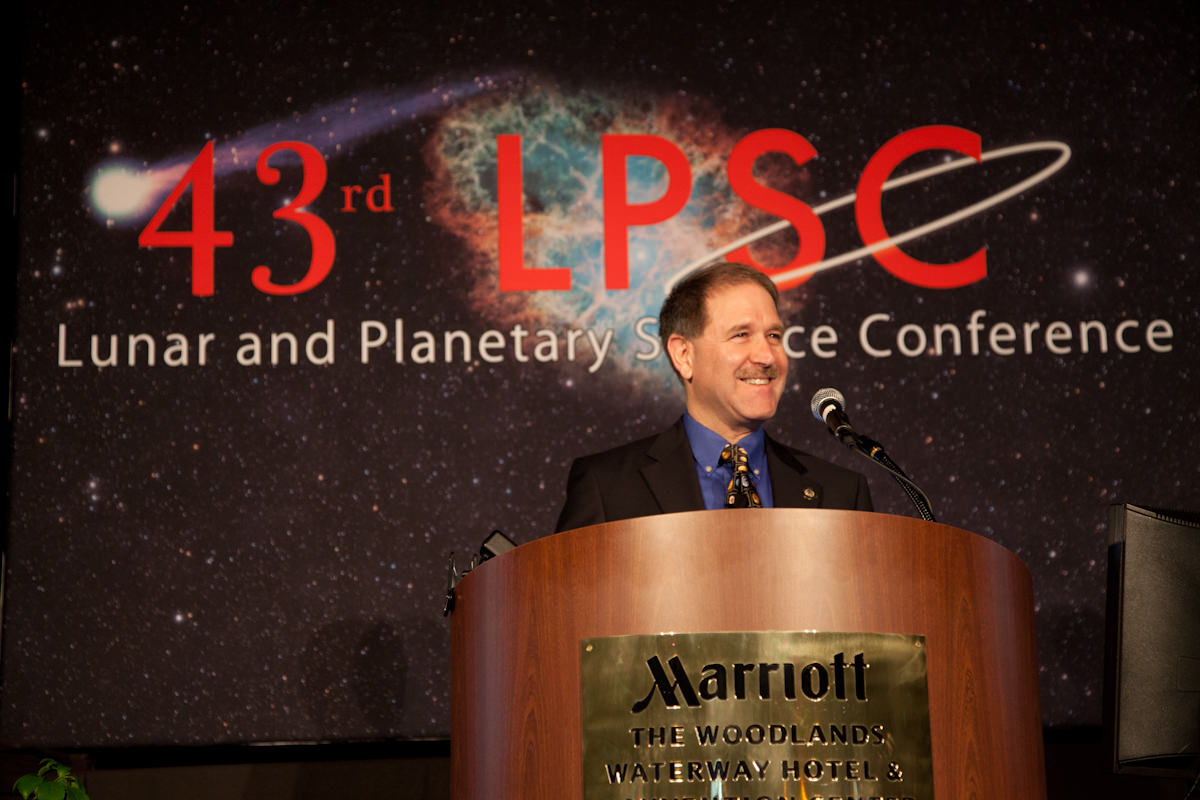[/caption]
“Flat is the new up,” said NASA’s new Associate Administrator for the Science Mission Directorate, John Grunsfeld, attempting to bring a bit of levity to the outlook for NASA’s proposed 2013 budget. Grunsfeld was speaking to a shellshocked community that will be taking the biggest hit in the NASA budget decrease: planetary scientists attending the Lunar and Planetary Science Conference this week in The Woodlands, Texas. There weren’t many jokes or laughs during Grunsfeld’s talk; nor from Jim Green, NASA’s Planetary Science Division Director. Both gave short remarks and then answered questions from the audience at “NASA Night,” the annual NASA Headquarters briefing event at LPSC.
“I wish I had a good succinct answer that this was punitive for overruns on the Mars Science Lab or JWST (James Webb Space Telescope), but this is not a Pavlovian system,” said Grunsfeld. “It comes down to tough trades: do we cut across the board, or do we pick some area? Sadly, it was decided that planetary science was the area.”
President Obama’s proposed FY 2013 budget would eliminate $300 million from the agency’s Planetary Sciences Division, a 21% cut from the $1.5 billion it received for 2012.
“We essentially lost the ability to create new missions,” Grunsfeld said.
Sitting among the people who, because of this proposed budget “whacking” (as Grunsfeld called it), will likely lose jobs or see their life’s work delayed or canceled, it was hard not to believe that this particular budgetary decision is wrong in every way possible. NASA would be slashing what many believe is the space agency’s most successful program.
“A 20% budget cut will likely equal 20% loss of jobs,” one commenter from the audience said. “People who land missions on Mars will lose their jobs, and when we get to the stage of landing humans on Mars, those with the know-how won’t be there.”
President Obama has stated he will see astronauts on Mars in his lifetime, so the plan to put the Mars program essentially on hold is extremely short-sighted, if not ironic.
“What a lot of people don’t realize is these cuts will most deeply impact the youth in our field,” wrote Dr. Pamela Gay in her StarStryder blog. “Many senior people who normally can find funding for themselves and a small fleet of postdocs and students will now just be funding themselves. It’s hard. It’s ugly. Especially when we work so hard to get people to get educations in this field.”
Planetary scientist Jim Bell, who is also President of The Planetary Society, along with Bill Nye, TPS’s Executive Director, both gave impassioned pleas for everyone – and especially for Grunsfeld and Green – to “fight back” against the cuts and request a review of “the largest crisis facing Planetary Science.”
Grunsfeld said he and Green are there to fight for the scientists and the missions. “Jim (Green) could have thrown his badge on the table (in response to the budget proposal), but he decided to stay and fight,” Grunsfeld said. He offered hope by reminding everyone how in 2004 when he was NASA’s chief scientist, the decision was made to not do the final repair mission to Hubble. That decision was eventually reversed. “History tends to repeat itself,” he said.

Grunsfeld and Green both stressed how the scientists — and anyone in attendance or watching the webcast of the event — should spread the word to the general public about the importance of planetary science and also about contacting their congress-people – the ones who make the final decision about the budget.
“Without question, we must keep our eye on the ball this year,” Green said. “Our top priority for the Planetary Science Division this year is to make the landing of the Curiosity rover a success. Tell everyone about this, relate this to your neighbor. We should not let this opportunity go by without relaying it to our stakeholders, the general public. This is such an important event, and a success will compel this nation to invest more in planetary science.”
But yet, NASA’s Education and Public Outreach budget has been cut from $136 million in FY12 to $100 million in the FY13 request.

One of the most perplexing issues about the budget cuts is how NASA’s involvement in future international Mars missions, an orbiter and lander called ExoMars — with instruments and science teams already selected for parts of the mission — would be cancelled. This leaves the international partners in the lurch, damages NASA’s reputation among the international science community and puts in doubt the possibility of any future collaboration.
Yet, Green said in his talk that NASA needs to “deliver on our international commitment,” and NASA officials often tout the incredible success of the international cooperation of the International Space Station – saying it is a model for future international missions.
NASA Administrator Charlie Bolden has asked the Science Mission Directorate and Grunsfeld to reformulate an agency-wide Mars exploration strategy, where they are now suggesting a smaller, US-only Mars mission in 2018.
But could a smaller mission be less expensive and offer anywhere near the amount of science that could have been attained with the joint ExoMars mission?
“Can we recapture the Mars program?” Grunsfeld asked. “We’re not just going to look at 2018 mission but a much larger Mars program. It will be an enormous amount of work, not new analysis, but compiling inputs you (the scientists) have made in the past, and where we are in the science to see what kind of path forward makes sense.”
Grusnfeld and Green also suggested a future melding of science and human spaceflight-related missions as a way to get more funding for Mars missions. But when asked by Universe Today for an example of a “dream” Mars science mission within a scenario of a human spaceflight precursor, neither could come up with a really enticing idea.
However, Grunsfeld said science at NASA would stand to benefit from developments in human exploration and space technology. “It might be a bit of a stretch, but imagine what kind of planetary mission you could launch with a 70 metric ton launch capability,” he said, referring to the Space Launch System’s big rocket that is in the preliminary stages of being developed for future human mission to either an asteroid, the Moon or Mars.
One piece of good news: Green announced that the GRAIL mission has already received a mission extension, as well as MESSENGER, which was announced earlier. Still hanging in the balance are extended missions such as for Kepler and MER, the decisions on which will be made by this summer, Green said.
The outlook for the start-up of production of Pu-238 is not brilliant – and for any future outer planet mission, this is crucial for power for the spacecraft, and ultimately, for science. The Department of Energy did not receive any funding for a re-start, so it looks as though NASA may have to go it alone and pay the entire costs of start-up and reproduction.
Surely, it was a tough situation for Green and Grunsfeld to be in, especially for Grunsfeld – a true scientist, astronaut and ‘Hubble Hugger’ who just started his new job at NASA HQ in January. “I’m trying to look at big picture. I come from an environment where I’ve loved the partnership between humans and science. When NASA has done well overall, science has done well. So we are in tough times, and NASA needs to have a cohesive vision.”
So, it may come down to grassroots support for NASA to possibly change the current of action. While the administration proposes a budget, but it’s Congress that actually enacts the budget and appropriates the money, so anyone who is passionate on this subject needs to contact their representatives.
Inspired by Neil de Grasse Tyson’s recent suggestion during testimony to Congress (see video below) that NASA should receive a full penny on the dollar of the national budget ($37.5 Billion) instead of less than half a cent at the $17.7 billion now proposed, a student named John Zeller has started a website, Penny4NASA., which offers templates for letters to Congress, petitions on Change.org and more.
The Planetary Society is also mounting a campaign to restore the science funding to NASA.
We’ll add more links to ways to support science and planetary missions as they come in.


I’d sign that petition if I were an American resident.
Unfortunately, President Obama is going to take the hit for this, when in reality, it’s not his fault. I sincerely hope that no one loses their position over this, but I also hope that anyone who is affected doesn’t vote for the alternative Presidential candidate this fall. The current cuts to NASA’s budget will seem like a gift in comparison to what the other side might propose.
Of course it can, in our fantasy world where politicians listen to scientists
I guess they can save their budget and spend less money doing the same thing or more. But who listens to us, real people or to scientists?
I really wish politicians start using people’s money (because their tax money is our money) to really understand the universe and do something about aging, because life is the most important thing in the world. I really wish that.
I hope that enough people realize how important this is and something is done about it. Such a small change could completely turn this nation around! Instead of ridiculous bailouts and crap government projects put the money into NASA! Heck put a tiny fraction into NASA, anything is better than the current agenda.